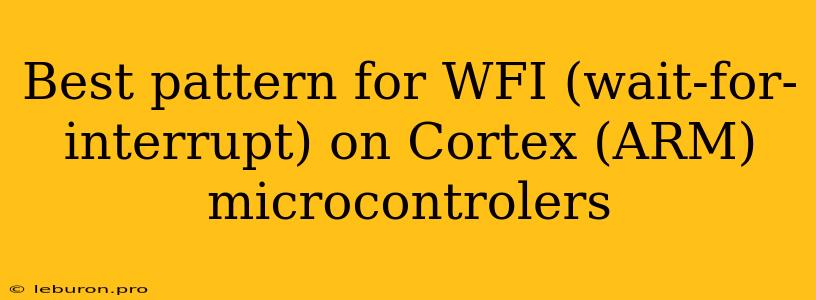The efficiency of interrupt handling is paramount in real-time systems, especially when working with embedded systems based on ARM Cortex microcontrollers. One common approach is to employ a Wait-For-Interrupt (WFI) pattern, where the processor enters a low-power state until an interrupt occurs. This technique can significantly reduce power consumption while ensuring responsiveness to critical events. However, the optimal implementation of WFI can vary depending on the specific application requirements and microcontroller architecture. This article delves into the best patterns for implementing WFI on Cortex-M microcontrollers, examining their trade-offs, and providing insights into optimizing interrupt handling for maximum efficiency.
Understanding WFI and Cortex-M Architecture
What is WFI?
WFI (Wait-For-Interrupt) is an ARM instruction that puts the processor into a low-power state until an interrupt occurs. This state consumes significantly less power than the normal running state. Once an interrupt is received, the processor automatically wakes up and begins executing the interrupt handler. This strategy is highly beneficial in applications where energy conservation is a primary concern, such as battery-powered devices or systems that require long periods of inactivity.
Cortex-M Microcontroller Architecture
ARM Cortex-M microcontrollers are widely used in embedded systems due to their low power consumption, high performance, and versatile architecture. They feature a dedicated interrupt controller that manages interrupt requests from peripherals and other sources. The WFI instruction works closely with the interrupt controller to efficiently handle interrupts and manage power consumption.
Best Patterns for Implementing WFI
The choice of WFI implementation strategy depends on several factors, including:
- Frequency of interrupts: If interrupts occur frequently, the overhead associated with waking up the processor might outweigh the power savings.
- Interrupt latency requirements: Some applications demand low interrupt latency, requiring a strategy that minimizes the time between an interrupt and the start of the interrupt handler.
- System complexity: In complex systems with multiple interrupt sources, managing the WFI state effectively becomes crucial.
Here are some of the best practices and patterns for implementing WFI on Cortex-M microcontrollers:
1. Basic WFI Implementation
The most straightforward way to use WFI is to execute it directly in the main loop:
int main(void)
{
// Initialization code...
while(1) {
// Task execution...
// ...
__WFI(); // Enter WFI state
}
}
This approach allows the processor to enter WFI whenever there are no active tasks or other processing to perform. This simple pattern is suitable for applications with infrequent interrupts and minimal latency requirements.
2. WFI with Timeout
In scenarios where there is a need for periodic tasks even in the absence of interrupts, a timeout mechanism can be implemented along with WFI:
int main(void)
{
// Initialization code...
uint32_t timeout_counter = 0;
while(1) {
// Task execution...
// ...
__WFI(); // Enter WFI state
// Check for timeout condition
if (timeout_counter > TIMEOUT_VALUE) {
// Execute periodic task
// ...
timeout_counter = 0;
} else {
timeout_counter++;
}
}
}
This pattern uses a timer or counter to track the time spent in the WFI state. When the timeout value is reached, the processor wakes up and executes the periodic task before re-entering WFI.
3. WFI with Interrupt Priority Management
In systems with multiple interrupt sources, prioritizing interrupts and managing their latency is crucial. The Cortex-M architecture allows for setting interrupt priorities, ensuring that high-priority interrupts wake up the processor from WFI immediately while lower-priority interrupts can wait.
void ISR_HighPriority(void)
{
// Handle high-priority interrupt...
}
void ISR_LowPriority(void)
{
// Handle low-priority interrupt...
}
int main(void)
{
// Initialization code...
// Set interrupt priorities...
while(1) {
// Task execution...
// ...
__WFI(); // Enter WFI state
}
}
This approach ensures that critical events are handled promptly while less urgent events can wait for the processor to be available.
4. WFI with Power Management Units (PMUs)
For advanced power management, Cortex-M microcontrollers often include Power Management Units (PMUs). PMUs offer a wide range of features, such as:
- Multiple low-power states: Beyond the basic WFI state, PMUs allow for deeper sleep modes with even lower power consumption.
- Dynamic voltage scaling: PMUs can dynamically adjust the processor voltage based on the workload, further reducing power consumption.
- Peripheral power management: PMUs enable selectively powering down peripherals when not in use, contributing to overall system energy savings.
By leveraging PMU capabilities, you can significantly optimize the power consumption of your system while using WFI effectively.
Optimizing WFI Implementation
- Minimize interrupt latency: Reduce the execution time of interrupt handlers to minimize the time spent outside the WFI state.
- Use interrupt coalescing: Group similar interrupts into a single handler to reduce the number of times the processor wakes up.
- Enable sleep modes: If your application supports it, use deeper sleep modes provided by the PMU to maximize power savings.
- Profile power consumption: Measure the power consumption of your system in different scenarios to identify areas for improvement.
- Optimize code for power efficiency: Avoid unnecessary operations and data accesses to reduce power usage.
Conclusion
Efficiently using WFI on Cortex-M microcontrollers is crucial for achieving optimal power consumption in embedded systems. The best pattern for implementing WFI depends on the application requirements and the specific microcontroller architecture. By understanding the different patterns, optimizing interrupt handling, and leveraging power management units, you can significantly enhance the energy efficiency of your embedded system while maintaining responsiveness to critical events. Through careful implementation and optimization, WFI becomes a powerful tool for extending battery life, reducing power consumption, and enhancing the overall performance of your embedded system.
